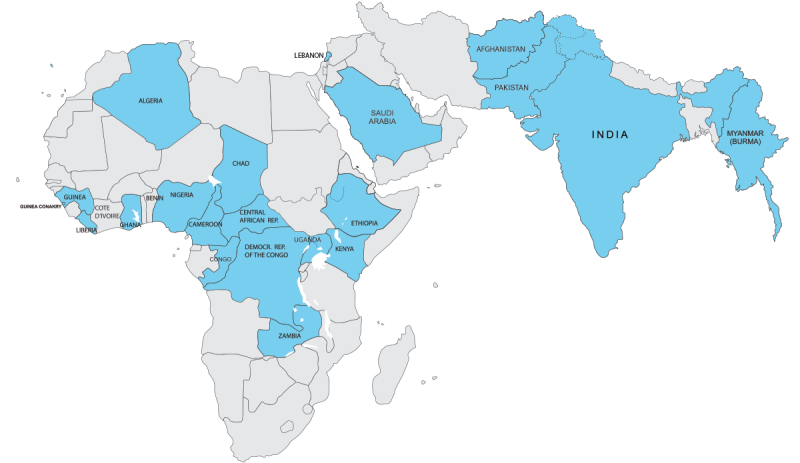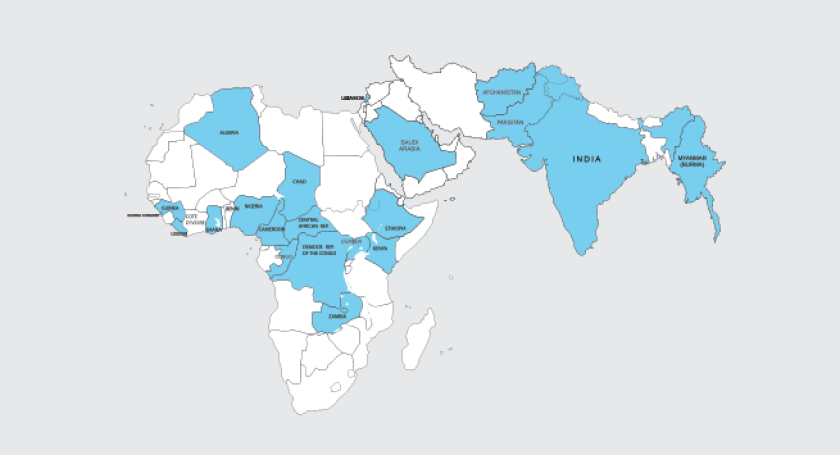Established in 2007, i-eng Group is a leading provider of EPC and O&M services for the telecom and power industries in Africa and other emerging markets. Building on operations in 18 countries ieng established CREI (Communication and Renewable Energy Infrastructure) as its ESCO arm. Leveraging on the reputation, operational expertise and network of ieng Group, CREI aims to become a leading player in the ESCO industry. TowerXchange speak to ieng Group’s Co-CEO, Kadri Hakim to catch up on the company’s latest developments and how ieng Group is strengthening its position as an invaluable partner to the African and Asian telecom markets.
TowerXchange: Please can you introduce ieng Group and its ESCO subsidiary CREI.
Kadri Hakim, Co-CEO, ieng Group:
ieng Group was established in 2007 in Ghana and is now present in 18 countries in Africa and Asia. We are a leading provider of O&M and EPC services for the telecom and power industries in the region. We currently employ 2,000 employees across our operations.
Our two subsidiaries are GreenPole, who specialises in the design, supply and manufacturing of hybrid power solutions (used for all our ESCO projects) and Eki.Struct who specialises in the design, supply and manufacturing of telecom steel structures.
The Group established CREI (Communication and Renewable Energy Infrastructure) as its investment arm that develops, owns and operates a portfolio of renewable energy assets across Africa and Emerging Markets. Basically, it just made sense to create the investment vehicle for our ESCO projects aiming to become a leader ESCO player while leveraging on the reputation, operational/technical expertise and network of ieng Group. We believe in reducing environmental impact and saving on CO2 emissions by deploying more energy-efficient power solutions thus providing a valuable alternative to operators that seek to outsource their power generation requirements.
Figure one: ieng Group’s geographical footprint

Figure two: ieng Group’s range of telecommunication services

TowerXchange: What are the advantages for a MNO working with CREI as an ESCO partner? How can the ESCO model be versioned to suit different priorities?
Kadri Hakim, Co-CEO, ieng Group:
One of the main advantages we have is that our group offers a fully integrated solution covering all the scope related to ESCO allowing a single point of contact with the client. We design and supply our own GreenPole Hybrid Power System (HPS), we handle the full construction scope from shipping, warehousing, transportation to installation and commissioning, we then handle the full O&M scope in-house which is our main strength as a Group. I believe this is the main reason behind the high quality of our service and our attractive competitive offering,
The ESCO model can be applied in so many different models and tailor made to clients’ networks and need. To list few examples, we could propose an ESCO model: - on the whole network or on only specific sites of the network where the ESCO business case is more attractive like off-grid or difficult access sites, - ESCO owning the power assets or keeping the ownership with the client; - guaranteeing the energy fees (fuel and grid) or just pass-through, and many more alterations. The ESCO is a 10+ years partnership with the client, we believe the ESCO partner need to understand and align as much as possible with the strategy of the client and accordingly offer a tailored ESCO version that is in line with the client’s objectives.
TowerXchange: Can you take me through the phases of a project from agreeing an ESCO contract, to auditing and taking control of the sites, then the process of modernising equipment?
Kadri Hakim, Co-CEO, ieng Group:
Once the ESCO Master Service Agreement (MSA) is signed the first step is to undertake a thorough audit of all the sites under consideration and identify site characteristics including: grid availability, space on the site, telecom equipment load.
Those criteria are needed to design the best fit and most efficient HPS for each site. We usually aim to install as many solar panels on off-grid sites to achieve the lowest TCOs and highest savings.
The following phase is the fund raising process which is followed by the manufacturing and supply of the HPS. During this phase, we take over the network of the client and handle the full O&M scope while still using the existing power equipment. We always achieve the first increase in network availability at this stage, a major step towards a successful partnership. After that we ship, deliver and install the HPS on each site; once commissioned, the site becomes operational under the ESCO model. The installation and commissioning of the equipment is a very delicate and crucial stage in determining the system’s performance, if not done properly we won’t reach the projected fuel consumption levels and hence jeopardizing the whole model. Once the site is under ESCO model, we again achieve a higher network availability, in line with the agreed SLA of the signed ESCO MSA.
TowerXchange: How do you guarantee improvements in site performance given the operational challenges?
Kadri Hakim, Co-CEO, ieng Group:
Improving the site performance is based on three main factors; the HPS design and efficiency, the installation and commissioning, and the operation and maintenance of the site over a period of 10 years.
We design and supply our own GreenPole HPS. We have supplied more than 2000 HPS in the last five years, some of which are successfully operating under an ESCO model for more than four years.
We handle the installation and commissioning in-house, our team is expert in troubleshooting on GreenPole HPS, they have been doing it for the last five years and can perform the necessary actions in the most remote areas.
O&M in emerging markets is our core business, we’ve been maintaining sites for more than 11 years, and currently manage a portfolio of 14,000 sites, including networks in the most challenging markets like Afghanistan and DRC. This is probably the most important part because it is the only activity that is spread over 10 years. Also, and I always use this example; designing, installing and maintaining one HPS in your backyard is pretty straight forward, but managing many of them spread all over a country with a complex rural landscape is a different ball game altogether.
It is most probably our expertise and experience in those three areas that enable us to guarantee the performance of our services regardless of the operational challenges.
Kadri Hakim, Co-CEO, ieng Group:
TowerXchange: What are the typical improvements in site availability once sites transfer to ESCO-management?
Kadri Hakim, Co-CEO, ieng Group:
In our ESCO, we guarantee a power availability of 99.95% for the whole network including off-grid sites, and this is always a significant improvement on the existing network availability. It is difficult to say how much this improvement is over the Pre-ESCO availability, as the existing client network availability depends on several factors mainly; the condition of the existing power equipment, the site distribution/country landscape, and the site typologies. It is more difficult to secure a high availability on an off-grid sites in comparison to a grid connected site.
TowerXchange: How successful has the ESCO model been in attracting new investment to emerging market telecoms and energy?
Kadri Hakim, Co-CEO, ieng Group:
The ESCO model ticks the right boxes for investors and funds, it is related to infrastructure in developing markets and delivering renewable clean energy – we align our goals to provide a positive impact and socio-economic benefit with both our investors and clients.
We are very pleased to announce closing our latest financing deal for Orange ESCO in the Central African Republic with SunFunder, based out of Kenya specialised in providing innovative debt financing for solar enterprises working in Emerging and Frontier Markets.
Despite the difficult times we are all facing, the ride was very smooth with SunFunder and we are happy to have found the right partner – we aim to collaborate together on our upcoming projects and have many more opportunities together.
TowerXchange: What lies in your future, will ESCOs evolve by serving community power, or commercial and industrial off-takes?
Kadri Hakim, Co-CEO, ieng Group:
This is something we are seriously looking into. We currently generate electricity for telecom sites in rural area with no grid, so expanding our power systems to cater for communities just makes so much sense. However, the implementation is not straight forward and much more complex than the ESCO model. Several new complexities come into play, the likes of: revenue collection, licensing, regulatory framework, pricing, consequences of grid reaching the area in the future, et cetera.
And those factors are very country specific, so what may seem to work in a country doesn’t necessary work in other countries. This project is currently a work in progress, and we plan to test mini-grid systems in few countries. We have seen some MNOs interested in serving community power, and they are collaborating with us to see how we can achieve this together by finding solutions to identified challenges (for example the MNO mobile money platform might be a solution for the revenue collection).
TowerXchange: Please sum up how you see the prospects for ESCOs over a turbulent year ahead.
Kadri Hakim, Co-CEO, ieng Group:
We didn’t see clients cancelling any of the ongoing ESCO RFPs due to Covid-19, some RFPs have been delayed or extended in view of the situation but all clients are still keen to move forward with their ESCO projects. In the end, MNOs still need their sites to be maintained and having a good reliable network is needed more than ever during this time not to mention the benefits of outsourcing power complexity to a third reliable party. In our opinion, we believe that ESCO benefits are reinforced during tough periods like this: allowing savings, MNOs can focus on its core network, no upfront investment, outsourcing power complexity and improved network availability.
In regards to our ongoing ESCO contracts, the projects are moving forward; we have put in place BCPs (Business Continuity Plans) which are updated on weekly basis and shared with our clients to navigate through this unusual period. It is a collaboration process with all the involved parties to ensure we overcome the challenges faced during this period. It hasn’t been straight forward, but we are basically taking all required measures to ensure the projects are being delivered and we are achieving our contractual SLAs. Our group is ISO 22301:2012 certified for business continuity management system, and this is helping us manage during this difficult period.

